
































































A dirndl is the name of a traditional feminine dress worn in Austria, South Tyrol and Bavaria. It is based on the traditional clothing of Alps peasants. Dresses that are loosely based on the dirndl are known as Landhausmode ("country-inspired fashion").
Lederhosen are breeches made of leather; they may be either short or knee-length. The longer ones are generally called Bundhosen or Kniebundhosen. Once common workwear across Central Europe, they are now considered a folk costume associated particularly with Bavaria and Austria.
The Dirndl, or female dress of "Tracht", also emerged in the 18th century as a servant's or maid's dress. This simple dress generally consisted of a blouse, bodice, full skirt and an apron and it was practically suited for a woman's work around the home or a farm at the time. Women typically wore slightly different styles and fabrics in the winter and in the summer. The winter dirndl was often a full dress with long sleeves, made of heavy cotton, linen or wool with warm skirts and aprons. In contrast, the summer dirndl was made of lightweight cotton and short-sleeved blouses were worn under sleeveless, tailored bodices. Just as the Lederhosen experienced a fashion trend among the nobility, the dirndl was also adopted into the upper echelons of society in the late 1800's, around 1870. Suddenly, the simple dresses made of practical fabrics, were transformed into very stylish, colorful dresses often made of silk, satin and other expensive fabrics. They then also evolved into dresses worn for regional pride and tradition, with each region taking on distinct differences in colors and style.